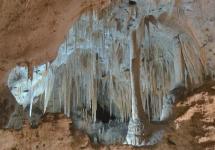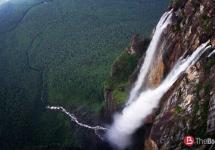Buryatia is a republic within the Russian Federation located in Eastern Siberia. The satellite map of Buryatia shows that the region borders on Mongolia, the Republic of Tuva, the Trans-Baikal Territories and the Irkutsk Region. The territory of the region is 351,554 square meters. km.
Buryatia is divided into 4 cities, 29 urban-type settlements, 614 rural settlements and 21 administrative districts. The largest cities in the region are Ulan-Ude (the capital), Severobaikalsk, Kyakhta, Gusinoozersk and Selenginsk.
The economy of Buryatia is based on metalworking, mechanical engineering, food, electricity and timber industries. There are 700 mineral deposits on the territory of Buryatia, of which 247 are gold deposits.
Lake Baikal in Buryatia
Brief history of Buryatia
In 1206, Temujin (Genghis Khan) united the Mongol tribes and created the Great Mongol Empire. In the 16th century, the empire collapsed. In 1703 Buryatia was annexed to Russia.
In 1918, the region was occupied by Japan, then the United States. In 1920, the region became part of the RSFSR. In 1921, the Buryat-Mongol Autonomous District was formed, which was transformed in 1923 into the Buryat-Mongolian SSR. In 1992, Buryatia becomes a sovereign republic within the Russian Federation.

Valley of volcanoes in the Eastern Sayan mountains in the Okidon valley in Buryatia
Sights of Buryatia
On a detailed map of Buryatia, you can see the main attraction of the region - Lake Baikal with the tourist and recreational zone "Baikal Harbor". It is recommended to visit the Baikalsky and Barguzinsky reserves, Tunkinsky and Zabaikalsky national parks.
In Buryatia, it is worth visiting the Museum of the History of Buryatia, the Ethnographic Museum of the Peoples of Transbaikalia, the Valley of Volcanoes, the Holy Trinity Selenginsky Monastery, as well as the largest cities of the region.
Tourist notes
Gulrypsh - a summer cottage for celebrities
There is an urban-type settlement Gulrypsh on the Black Sea coast of Abkhazia, the appearance of which is closely associated with the name of the Russian philanthropist Nikolai Nikolaevich Smetsky. In 1989, due to the illness of his wife, they needed to change the climate. Case decided the matter.Car roads
On the satellite map of Buryatia, three federal highways passing through the republic are clearly visible:
- - Tunkinsky tract (A333, former A164): Irkutsk region (Kultuk village) through Mondy (Buryatia) to the Mongolian border; beyond the Mondy border crossing, the route continues on the territory of the neighboring state;
- - Kyakhtinsky tract (A340, former A165): from Ulan-Ude to Kyakhta and further to the Mongolian border;
- - "Baikal" (federal P258, formerly M55): from Irkutsk to Chita through Ulan-Ude.
Looking at Buryatia on the map of Russia, one can see that the beginning of the Tunkinsky tract is associated with a branch of the federal highway "Baikal" (near the village of Kultuk). From "Baikal", which is a continuation of "Siberia", the Kyakhtinsky tract departs in the direction of Mongolia. Tunkinsky and Kyakhtinsky tracts are two of the four federal roads connecting the Russian Federation with Mongolia. There are also twelve regional roads: Mondy - Orlik (O3K-035), Ulan-Ude - Ulyunkhan, Romanovka - Bogdarin (P437), Mukhorshibir - Kyakhta, Shergino - Zarechye, Turuntaevo - Treskovo and a number of others.
Railway transport
Sections of two major railways pass through the republic: the Trans-Siberian and the Baikal-Amur. The Transsib goes from west to east along Lake Baikal, passes through the capital of the region and has a branch in the direction of Mongolia from the Zaudinskaya station. BAM goes along the northern part of the subject, passing through the Severo-Muisky ridge along the 15-kilometer tunnel of the same name. All Buryat railways belong to the East Siberian railways.
Map of Buryatia with cities and villages
The map of Buryatia with the regions shows that there is only one large city in the republic - the capital Ulan-Ude. The population of the administrative center of the subject exceeds 400 thousand people. The rest of the cities are comparable in population and size to the township. The population of the largest of them does not even reach 25 thousand people (Gusinoozersk and Severobaikalsk).
On the page is an interactive map of Ulan-Ude from the satellite. More info on + weather. Below are satellite images and real-time Google Maps search, photos of the city and the republic of Buryatia in Russia, coordinates
Satellite map of Ulan-Ude - Russia
We observe on the Ulan-Ude satellite map exactly how the buildings are located on Trubachev and Tereshkova streets. Viewing the scheme of the territory of the district, highways and highways, squares and banks, stations and train stations, address search.
The satellite map of Ulan-Ude presented here online contains images of buildings and photos of houses from space. You can find out where are the st. Borsoev and Revolution. Using the search service Google Maps, you will find the desired address in the city and its view from space. We advise you to change the scale of the scheme +/- and move the center of the image to the desired side.
A detailed satellite map of Ulan-Ude (hybrid) and the region is provided by Google Maps.
Coordinates - 51.8266,107.5888
Satellite map of Buryatia. Explore the satellite map of Buryatia online in real time. A detailed map of Buryatia was created on the basis of high-resolution satellite images. As close as possible, a satellite map of Buryatia allows you to study in detail the streets, individual houses and sights of Buryatia. The satellite map of Buryatia can be easily switched to the regular map mode (diagram).
Buryatia - a region in Russia that is part of the Siberian Federal District. The administrative center of Buryatia is the city of Ulan-Ude. The beginning of Buryatia was laid in 1666 with the appearance of the first wooden fortress in this region, where the city of Ulan-Ude later grew up.
The sharply continental climate of Buryatia is characterized by a bright differentiation of the seasons. Winter in Buryatia is cold, but dry, without a significant amount of snow. The air temperature in winter is -20 ... -22 C. Summer is warm, but short with an average July temperature of + 18C.
Tourism in Buryatia quite well developed thanks to its numerous natural resources. One of the most visited resorts in Buryatia is Arshan, whose name is translated from the Buryat language as “healing water”. The largest number of tourists is observed here in summer, when there are many opportunities for active and interesting recreation. Arshan today is one of the largest resorts in Buryatia, which has been named the Pearl of Transbaikalia.
Another popular resort is Barguzinsky Bay, the largest bay of Lake Baikal. In the summertime, it attracts thousands of tourists from all over Siberia.
The best health resort in the region is Nilova Pustyn, which is located on the territory of the Tunkinsky National Park. There are more than 300 natural attractions in Buryatia. Undoubtedly, the most important of them, which made Buryatia famous all over the world, is Lake Baikal. This is the deepest and purest lake on the planet, which is even called the sea in Siberia.
In addition, there are many national parks and reserves in Buryatia. These are the Zabaikalsky National Park, protected by UNESCO, the Tunkinsky National Park, the Dzherginsky Reserve, etc. In each of these parks you can see unique natural objects: mountains, caves, rivers and lakes.
Satellite map of Buryatia
Satellite map of Buryatia. You can see a satellite map of Buryatia in the following modes: a map of Buryatia with the names of objects, a satellite map of Buryatia, a geographical map of Buryatia.Buryatia - a region in Russia that is part of the Siberian Federal District. The administrative center of Buryatia is the city of Ulan-Ude. The beginning of Buryatia was laid in 1666 with the appearance of the first wooden fortress in this region, where the city of Ulan-Ude later grew up.
The sharply continental climate of Buryatia is characterized by a bright differentiation of the seasons. Winter in Buryatia is cold, but dry, without a significant amount of snow. The air temperature in winter is -20 ... -22 C. Summer is warm, but short with an average July temperature of + 18C.
Tourism in Buryatia quite well developed thanks to its numerous natural resources. One of the most visited resorts in Buryatia is Arshan, whose name is translated from the Buryat language as “healing water”. The largest number of tourists is observed here in summer, when there are many opportunities for active and interesting recreation. Arshan today is one of the largest resorts in Buryatia, which has been named the Pearl of Transbaikalia. www.site
Another popular resort is Barguzinsky Bay, the largest bay of Lake Baikal. In the summertime, it attracts thousands of tourists from all over Siberia.
The best health resort in the region is Nilova Pustyn, which is located on the territory of the Tunkinsky National Park.
There are more than 300 natural attractions in Buryatia. Undoubtedly, the most important of them, which made Buryatia famous throughout the world, is Lake Baikal. This is the deepest and purest lake on the planet, which is even called the sea in Siberia.
In addition, there are many national parks and reserves in Buryatia. These are the Zabaikalsky National Park, protected by UNESCO, the Tunkinsky National Park, the Dzherginsky Reserve, etc. In each of these parks you can see unique natural objects: mountains, caves, rivers and lakes.



